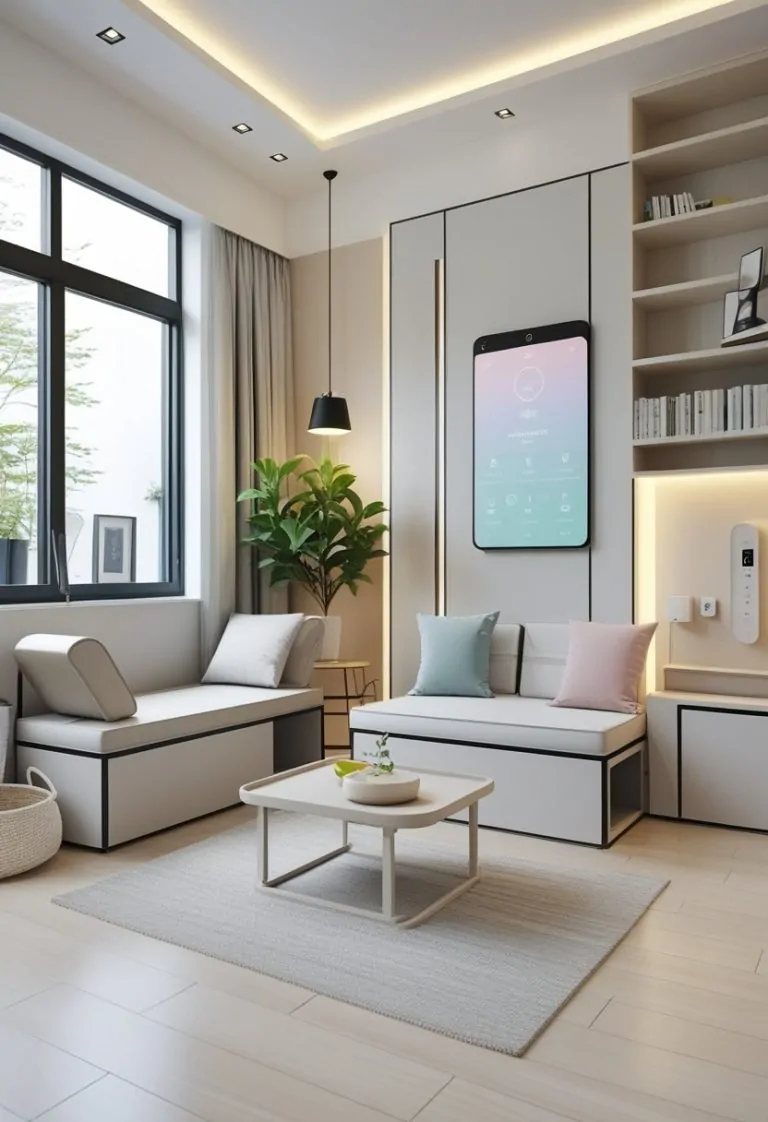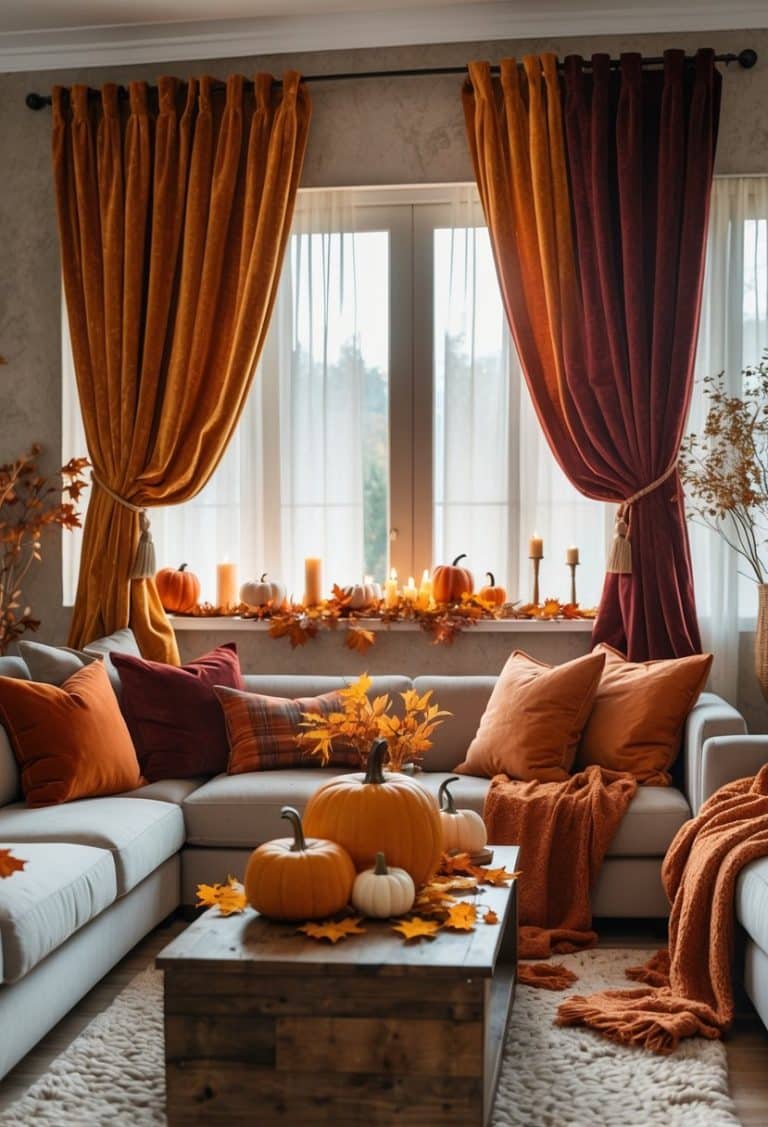22 Neutral Living Room Ideas for Timeless and Elegant Spaces

Neutral living rooms have become popular choices for creating calm and stylish spaces. They use colors like white, beige, gray, and brown to form a relaxing atmosphere that works well with many home styles.

Choosing a neutral palette gives homeowners flexibility to design a space that feels warm, welcoming, and timeless. This approach allows for easy updates with new furniture or decorations while keeping the room looking fresh and inviting.
1) Use a palette of creamy whites and warm taupes for a soft, inviting atmosphere

Creamy whites and warm taupes create a peaceful living room. These colors offer a balanced look that feels both gentle and welcoming.
Cream on the walls or big furniture keeps the space light and open. Taupe accents, like a sofa or area rug, add warmth and comfort.
This palette works well with wooden details and soft fabrics. Layering textures, like linen or jute, makes the room feel cozy without being busy.
2) Incorporate layered textures like wool throws and linen cushions for depth

Layering textures brings visual interest to a neutral living room. Using wool throws and linen cushions can add softness and warmth. Each texture stands out, making the space feel less flat.
Mixing materials like velvet, cotton, or leather with these staples can enhance depth. Laying a chunky blanket on a linen sofa or adding cushions in various fabrics creates a subtle, welcoming look.
Texture helps break up the sameness of neutral colors. It also invites people to relax and enjoy the space.
3) Choose plush, neutral-toned carpets to add warmth

Plush, neutral-toned carpets make any living room feel more comfortable and welcoming. Soft fibers provide warmth underfoot, especially on hard flooring.
Colors like beige, gray, and cream blend easily with most decor styles. Neutral carpets add texture and interest without becoming the main focus of the room.
Wool or natural fiber carpets are good choices for both comfort and style. Subtle patterns can bring depth while keeping the look simple and calm.
4) Opt for furniture in shades of gray or beige to maintain elegance

Furniture in gray or beige helps create a timeless and sophisticated look in a living room. These neutral tones work well with many different styles and color schemes.
Beige sofas and gray chairs can make the space feel calm and welcoming. Clean lines and simple shapes add to the elegant atmosphere.
Different textures like linen or velvet can add interest without making the room look busy. This keeps the decor simple and coordinated.
5) Add organic shapes through rounded coffee tables or curved sofas

Rounded coffee tables and curved sofas can soften the straight lines found in most living rooms. These shapes help break up the rigid feel of square or rectangular furniture.
They add visual interest and make the space feel more inviting. A curved sofa can become a gentle focal point. Pairing it with a round coffee table supports a sense of flow and comfort.
6) Combine cream and gray walls for a serene backdrop

Cream and gray walls work well together because both shades are soft and neutral. The mix creates a calm, balanced feel in the living room.
Cream walls add warmth and brightness, making the space feel welcoming. Soft gray brings a hint of coolness and modern style.
This simple color pairing makes it easy to add artwork, colorful pillows, or wooden furniture without clashing with the walls.
7) Integrate natural wood elements to bring subtle contrast

Natural wood pieces can add gentle contrast to a neutral living room. Items such as wooden coffee tables, shelves, or picture frames introduce warmth without overpowering the space.
Light woods like oak or maple work well for a soft, calm look. Darker woods like walnut create a more defined contrast but still blend in smoothly.
Using real wood also brings in a touch of nature, making the room feel grounded and inviting.
8) Use minimalist artwork with neutral colors for a calm focal point

Minimalist artwork in neutral colors helps create a calm, inviting space. Art with soft shades like beige, gray, and white finds balance without drawing too much attention.
Hanging a simple piece above the sofa or fireplace lets it become the main focus. Clean lines and gentle textures keep the look relaxed and uncluttered.
This approach fits well with neutral themes. It adds personality to the room but keeps the atmosphere peaceful.
9) Accent with black metal fixtures for modern sophistication

Black metal fixtures can give a neutral living room a clean, updated look. Items like coffee tables, shelving, or light fixtures made from matte black metal create bold, simple lines.
This contrast helps balance the soft tones of beige, gray, or cream. Black accents add visual interest without overwhelming the space.
Using only a few black metal pieces keeps the room feeling open and uncluttered.
10) Select translucent curtains in off-white for soft natural light

Translucent curtains in off-white let natural light fill the living room while keeping privacy. They create a gentle, airy feel that works well with neutral color palettes.
These curtains help make the space look brighter and more open. Off-white tones blend with many styles, from modern to farmhouse.
The light fabric allows the room to feel peaceful and welcoming without looking plain.
11) Introduce glass decor pieces to reflect light and maintain openness

Glass decor can help a neutral living room feel brighter and more spacious. Items like glass coffee tables, shelves, or vases let light pass through, which reduces visual clutter.
Mirrors and transparent furniture make small spaces feel larger without adding heavy shapes or colors. These pieces also work well with many design styles.
Placing glass accents near windows or light sources helps spread natural light across the room. This creates a simple, clean look that keeps the space feeling open.
12) Mix warm browns and oyster grays for versatile coordination

Warm browns add a cozy and inviting feeling to a living room. Oyster gray tones balance the look with their soft, subtle coolness.
Combining these two shades creates a flexible foundation for many decor styles. They work well with wood, metal, and natural fabrics.
This color mix supports both modern and classic designs. It’s an easy way to keep the space feeling balanced and welcoming.
13) Include plants in simple pots to enhance the organic feel

Plants in plain pots fit naturally in a neutral living room. They add a touch of green while keeping the look calm and uncluttered.
Simple ceramic, terracotta, or white planters work well. They blend with neutral colors and do not overpower the space.
Even a few plants, like snake plants or ferns, can boost the organic feeling. Arranging them in corners or near windows helps the room feel fresh and relaxed.
14) Pick neutral upholstery fabrics that are easy to maintain

Neutral upholstery fabrics are a smart choice for living rooms. Colors like beige, cream, and soft gray can blend with any decor. They create a calm, inviting space.
It’s important to choose materials that are simple to clean and resistant to stains. Fabrics such as microfiber, polyester blends, and faux leather are popular because they handle everyday wear well.
Easy-care fabrics help keep the furniture looking fresh. They are practical for families or anyone who wants a tidy space with less effort.
15) Incorporate layered lighting with floor lamps and sconces in muted tones

Layered lighting adds depth and flexibility to a neutral living room. Floor lamps in soft, muted finishes can provide gentle ambient light.
Wall sconces in similar tones offer focused light and highlight features like artwork or a reading chair.
Choosing lighting in muted colors keeps the look calm and balanced. Mixing different light sources also allows easy adjustment of mood and brightness.
16) Use neutral rugs with subtle patterns to unify the space

Neutral rugs with gentle patterns help bring a living room together. They connect furniture and decor without drawing too much attention. Soft stripes, tone-on-tone designs, or small geometric prints can add interest.
These rugs are easy to pair with different colors and textures. They also soften wood or tile floors. This approach helps keep the room calm and balanced.
17) Add beige or taupe ottomans for extra seating with style

Beige and taupe ottomans offer flexible seating options in a neutral living room. They fit well with different decor styles and add comfort and function to the space.
These ottomans can be used as footrests, small tables, or extra seats for guests. Their neutral color works well with most color schemes.
Some ottomans come with storage space, making them even more practical. They help keep the room tidy while adding a cozy touch.
18) Choose sleek storage solutions in matte neutrals

Sleek storage helps keep a living room looking clean and modern. Matte finishes in shades like beige, cream, or soft gray blend in with most neutral color schemes.
Built-in shelves or low-profile cabinets offer plenty of space to hide clutter. Woven baskets and closed consoles also work well and keep items out of sight.
Choosing simple handles and smooth lines on furniture keeps the look streamlined. This makes the whole space feel balanced and tidy without drawing too much attention.
19) Go for soft, muted green-grays for a subtle color variation

Soft, muted green-gray paint colors work well in neutral living rooms. These shades have delicate hints of green mixed with gray or blue undertones.
They add a gentle touch of color without being too bold or distracting. Muted green-grays can make the space feel fresh, relaxed, and inviting.
These calm tones pair nicely with wood, white, and natural textures to promote a serene atmosphere.
20) Integrate cozy knit blankets in natural fibers

Cozy knit blankets made from natural fibers like cotton or wool add warmth and texture to any neutral living room. These blankets look inviting when draped over a sofa or armchair.
Natural fibers help the space feel more grounded and comfortable. Chunky knit designs in cream, tan, or soft brown tones blend well with neutral colors.
Their soft touch makes the room more welcoming and encourages relaxation. Adding a knit blanket is a simple way to boost comfort without overpowering the space.
21) Select low-profile furniture to keep the room airy and balanced

Low-profile furniture helps a neutral living room feel open and balanced. Pieces that sit close to the ground let natural light move freely around the space.
Furniture with clean lines and simple shapes works well in this setting. It reduces clutter and supports a calm, spacious look.
Soft, neutral colors on the furniture can also keep the room bright and inviting without feeling crowded.
22) Use neutral-toned decorative pillows with varying textures

Neutral-toned decorative pillows bring a soft and calm feeling to the living room. By choosing pillows in shades like white, beige, or gray, the space feels open and easy to style.
Mixing different textures, such as linen, velvet, or knits, adds interest without needing bold colors. This mix keeps the room looking fresh and layered. Even with a simple color palette, textured pillows help create a cozy and inviting space.
Understanding the Appeal of Neutral Palettes

Neutral palettes are a popular choice for living rooms because they bring calmness and flexibility. They help rooms look modern yet timeless, blending easily with many types of décor and personal tastes.
The Psychology of Neutrals in Interior Design
Neutrals like beige, gray, cream, and taupe create a sense of stability and comfort in living spaces. These colors do not demand attention, so they allow furniture and textures to stand out without overwhelming the eye. Interior designers often choose neutrals to make spaces feel larger and more open.
Studies in color psychology show that people often feel more relaxed when surrounded by neutral tones. This makes them ideal for spaces meant for unwinding, like living rooms. A simple color palette also allows homeowners to update the room with new décor items or accent colors without major changes.
Designers use the following shades for their inviting, restful quality:
| Shade | Effect |
|---|---|
| Beige | Warmth, softness |
| Gray | Balance, calm |
| White | Clean, fresh |
| Taupe | Sophistication |
How Neutrals Affect Mood and Ambiance
Neutrals help create a peaceful environment by avoiding high-contrast colors that may feel harsh or energetic. When paired with other soft shades or natural textures, neutral colors can make a room feel cozy and welcoming. They often work well with wood, stone, or rattan for an organic touch.
Soft neutral backgrounds make it easy to change the mood of a room by adding or removing accent pieces. For example, a beige rug and gray sofa can support bright cushions or bold art without clashing. This adaptability is helpful for people who like to refresh their space without full makeovers.
Natural light in a room often reflects off neutral walls, making the area feel brighter during the day. At night, soft lighting and warm undertones in neutral colors can deliver a restful, homey ambiance.
Layering Textures and Materials in a Neutral Living Room
Layering different textures and materials adds depth and prevents a neutral living room from looking flat. Using a mix of soft fabrics, sturdy natural elements, and a variety of finishes helps create an inviting space.

Essential Textiles for Depth and Warmth
Textiles are important for making a room comfortable and interesting. People can use wool rugs, linen curtains, and velvet throw blankets to create layers. Each fabric feels different and can be used throughout the room to build up softness.
A simple way to do this is by mixing a knitted pillow with a smooth cotton sofa. Placing a faux fur or woven basket near a leather chair adds even more depth. Choosing different patterns in neutral colors, like small checks or stripes, helps the space feel lived-in without too much color.
Below is a list of recommended textiles and their effects:
| Textile | Look & Feel | Placement Ideas |
|---|---|---|
| Wool | Cozy and warm | Area rugs, throws |
| Linen | Light and airy | Curtains, cushions |
| Velvet | Plush and soft | Throw pillows, ottomans |
| Cotton | Clean and crisp | Sofas, slipcovers |
These layers work together to keep the room calming, yet visually interesting.
Incorporating Natural Elements
Adding natural materials balances out the softness of fabrics. Wood, stone, rattan, and even some plants bring subtle color and unique texture. These elements help ground the space and make it feel relaxed.
A wooden coffee table or side table pairs well with stone trays or ceramic vases. Baskets, whether used for storage or display, add a handmade feel. Displaying branches or dried flowers in a neutral pot introduces both organic texture and simple beauty.
Mixing materials like stone and wood, or metal and woven pieces, keeps the look clean and classic. Using a variety of shapes and finishes helps prevent the neutral room from feeling plain. Small touches, like a stone candleholder or a leather tray, complete the look without taking away from the peaceful atmosphere.






